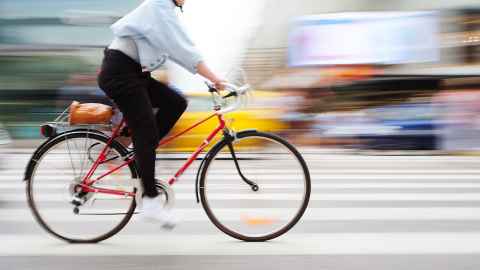Crunch point for climate-friendly commuting
5 April 2022
OPINION: Auckland needs to cut congestion and transport emissions. The good news, write Kirsty Wild and Alistair Woodward, is that we know how to do that.

Waiting until your roads are full to ‘reallocate’ space to climate-friendly transport modes is not for the faint-hearted. But that is the tough spot Auckland Transport finds itself in, with the release of a new draft parking strategy that aims to do just that by removing on-street parking on strategic transport routes.
Our climate plan commits us to reducing transport emissions by 60 per cent by 2030 to avoid the worst of climate change. The stakes are high - as recent floods and record rainfall highlight. Transport is key because it makes up a large and growing share of our emissions.
There is no need to wait for new technologies when there are simple and easy interventions that work fine. But on most New Zealand roads there isn’t any new space to magic up to create priority lanes for buses, bikes and other low-carbon commuting modes. Parking is it. Disability parking will always be a priority, but the rest of us will need to start getting used to being asked to park a little bit further away and ‘Walk 5 for climate.’
If it feels tough, it already is. Driving, and especially driving in congested conditions, is consistently shown to be the ‘highest stress’ transport mode. As well as having one of the highest levels of congestion in the Asia Pacific region, sprawl means Aucklanders also face longer commutes.
More hours each week travelling means less time for sleep, for eating properly, for spending time with family, and for participating in community life. At the 15-minute mark commute satisfaction drops. At the 40-minute mark life satisfaction drops. And at the end of every maddening journey, there is increasing anxiety that we won’t have anywhere to leave our car.
If we do not break out of this downward spiral New Zealand is unlikely to achieve its 2050 emissions target.
But that problem is not new. Nor has it been created by removing parking for bike or bus lanes. Population growth has filled every nook and cranny of our road network with cars. It’s a vicious cycle: more driving makes bus trips slower and less attractive, and it makes it much more dangerous to try to bike or walk, leading to....more driving.
If we do not break out of this downward spiral New Zealand is unlikely to achieve its 2050 emissions target. Dedicated, safe lanes for buses and cyclists must be part of the solution. They unblock the arterials of transport networks, and they reliably get cities moving again.
Auckland Transport is right to move as quickly as possible to repurpose arterial roads to create room for more sustainable, efficient modes. This is a system-wide problem: it requires system-wide thinking, consultation and debate.
We need to consult once on the whole plan, and then deliver it for all Aucklanders. Transport systems are networks. They can’t be consulted on and designed block by block. No-one expects, wants or would tolerate ‘bespoke’ motorways or rail lines that chop and change, petering out in places, and become wildly difficult to navigate or understand as you moved through different parts of the city.
Yet this approach, often driven by objections to moving a single carpark, has too long been tolerated when it comes to planning for low-carbon modes such as buses and bikes.
If your local bike lane took forever to build, is barely usable and it looks like it was designed by committee, rather than an engineer, it probably was. Change is needed and long overdue.
What about the cost to business? This question has been studied extensively around the world. And it is observed that moving parking does not have a negative effect on businesses, if it is replaced by high quality transport alternatives. Small pieces of ‘designed by committee’ bike or bus lane through a town centre don’t count here.
Get an engineer in to design it once and well, and connect it to a whole network if you want it to work for business. A recent international review of the economic impact of bike lanes found that if well designed they generally have a neutral or positive effect on local businesses.
The sooner we have whole functional networks of connected rapid bus and bike lanes, then the sooner that leaving the car at home sometimes will become a real possibility for Aucklanders. Not just a ‘good deed’, but a genuinely better way to get around our city.
Dr Kirsty Wild is a senior research fellow and Alistair Woodward is a professor at the School of Population Health at the University of Auckland. Their research focus is epidemiology and biostatistics.
This article first appeared in Newsroom.
This article reflects the opinion of the authors and not necessarily the views of the University of Auckland.
Media inquiries: Gilbert Wong, gilbert.wong@auckland.ac.nz